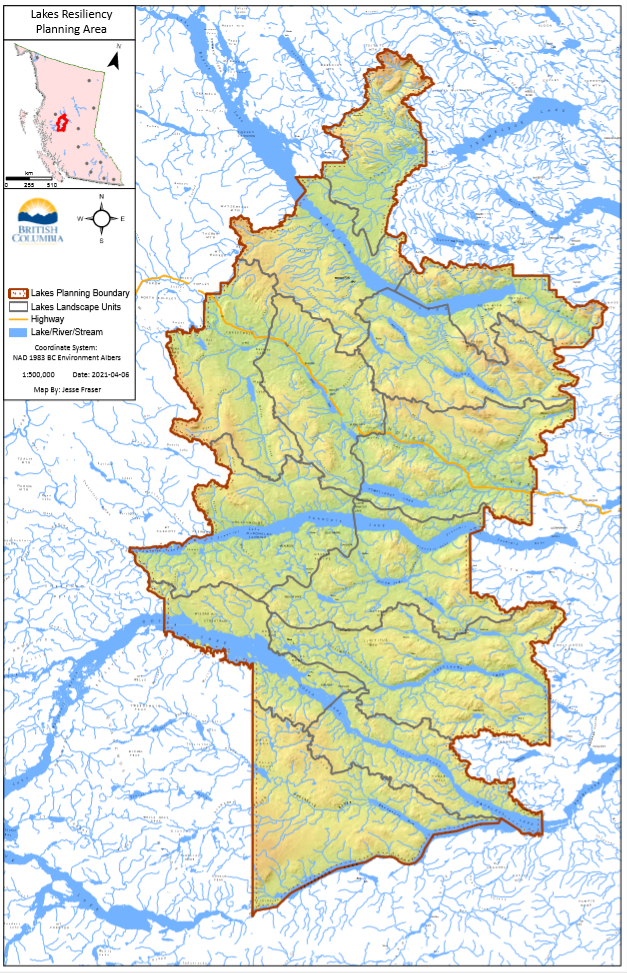Lakes Resiliency Project
The goal of the Lakes Resiliency Project is a forest management plan that will:
- Reduce wildfire hazards and decrease the risk of future catastrophic wildfires
- Create a more resilient forested land base
- Maintain ecological services and cultural values
- Contribute to the stability of the timber supply, jobs and a viable competitive forest sector
On this page
- What is the Lakes Resiliency Project?
- Lakes Resiliency planning area
- Lake Resiliency Project scope
- Who is involved with the Lakes Resiliency Project?
- When will the Lakes Resiliency Project be completed?
- Lakes Resiliency Project public engagement process
What is the Lakes Resiliency Project?
Following the Northern Conference for Wildfire Resiliency in Burns Lake in April 2019, the Ministry of Forests committed to working with First Nations, local communities, and interest groups in the Lakes planning area to create a more resilient forested land base. An initial public engagement was held in the fall of 2019. The feedback from this meeting suggested a new approach to sustainable forest management in the Lakes was needed.
From the feedback and information shared at the Northern Conference for Wildfire Resiliency, the Lakes Resiliency Project was established. The project aims to improve and develop stronger working relationships with First Nations, industry, and community groups to complete the goal of developing a forest management plan.
Lakes Resiliency Project planning area
The Lakes planning area covers about one million hectares in north-central British Columbia. The area contains the headwaters of important tributaries of the Skeena and Fraser watersheds, numerous lakes, and forested ecosystems. Several Provincial parks are located within the planning area as are both area-based and volume-based forest tenures.
While the forest ecosystem is dominated by lodgepole pine, hybrid spruce and subalpine fir (balsam), the past two decades of the mountain pine beetle, salvage activities and wildfire have changed the forested land base significantly.
Lakes Resiliency Project scope
The scope of the Lakes Resiliency Project is to:
- Review and amend the existing land use objectives established under the Lakes North and Lakes South Sustainable Resource Management Plans (SRMPs)
- Establish innovative landscape-level direction and guidance for the Lakes area that align with other initiatives
- Develop a forest management regime responsive to climate change and natural disturbances that promotes forest resilience
- Complete a forest landscape plan (FLP) pilot that, once established, will provide spatially explicit forest management direction
- Complete a comprehensive engagement process and develop key partnerships with First Nations and interested parties
- Coordinate across divisions and agencies to achieve unified outcomes and interest group efficiencies for forest and range licensees, First Nations, and the Nadina District
Who is involved with the Lakes Resiliency Project?
The Lake Resiliency Project team is working with First Nations, industry representatives, local communities, and across Provincial ministries and initiatives active in the Lakes planning area.
A group of technical representatives including First Nations, interest groups, licensees, land users and the Province will meet to review the data, develop a forest management plan, and recommend amendments to the land use objectives. There will be opportunities for the public to review and provide input at key milestones.
When will the Lakes Resiliency Project be complete?
The Lakes Resiliency Project is underway and is expected to conclude in 2025. As the project progresses, the material developed by the planning table will be available on this webpage at key milestones for the public to review and comment on.
Lakes Resiliency Project public engagement
Public engagement is ongoing throughout the duration of the Lakes Resiliency Project. Opportunities for review and comment of project materials will be provided on the Land and Water Planning platform.
Related initiatives and documents
Contact information
For more information, contact the Lakes Resiliency Project inbox.

